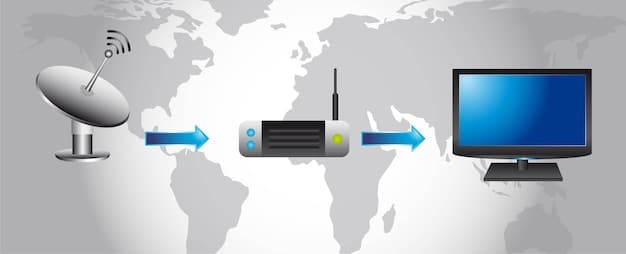The Evolution of Cable: From Basic Programming to Premium Originals

The evolution of cable television has transformed it from a provider of basic broadcast signals to a powerhouse of premium original programming, driven by competition, technological advancements, and changing consumer preferences.
The cable television industry has undergone a dramatic transformation since its inception. What started as a means to deliver basic broadcast signals to remote areas has evolved into a landscape dominated by high-quality, original programming that rivals, and often surpasses, traditional broadcast networks. This article explores the evolution of cable: from basic to premium original programming, examining the key factors and milestones that have shaped this industry into what it is today.
The Humble Beginnings: Community Antenna Television (CATV)
In the early days, cable television was not about original content or entertainment; it was about access. Community Antenna Television (CATV) systems emerged in the late 1940s and early 1950s as a way to bring broadcast signals to communities that had difficulty receiving them due to geographical barriers or distance from broadcasting towers.
The Role of CATV in Rural Areas
CATV systems primarily served rural and mountainous areas where over-the-air signals were weak or nonexistent. These systems used large antennas to capture broadcast signals and then distribute them to homes via coaxial cables. The focus was on clear reception and providing access to a few available channels.
Initially, cable companies offered only a handful of channels, primarily local network affiliates. The appeal was simple: a clearer picture and more reliable access to existing broadcast content. There was no concept of original programming or premium channels.

- Improved Signal Quality: CATV provided clearer and more reliable reception compared to traditional antennas.
- Access to More Channels: Even in its early stages, CATV could offer access to a few more channels than were available over the air.
- Community Connection: CATV systems often served as a community hub, providing a shared service to residents in remote areas.
The introduction of CATV marked the beginning of a new era in television. It laid the groundwork for the vast cable networks that would emerge in later decades, fundamentally changing how people consumed television.
Expanding Horizons: The Rise of Cable Networks
As cable technology advanced, so did the opportunities for content creation and distribution. The late 1970s and early 1980s witnessed the rise of cable networks that offered specialized programming, marking a significant shift from simply rebroadcasting existing content.
The Launch of HBO and Other Pioneers
Home Box Office (HBO) launched in 1972 and became one of the first premium cable channels, offering movies and live sports events for a monthly subscription fee. This model introduced the concept of paying for exclusive content, a revolutionary idea at the time.
Alongside HBO, other cable networks like ESPN (launched in 1979) and CNN (launched in 1980) emerged, catering to specific interests such as sports and news. These networks demonstrated the viability of niche programming and paved the way for a more diverse cable landscape.
Deregulation and Its Impact
The deregulation of the cable industry in the 1980s allowed cable companies to expand their offerings and increase subscription rates. This led to significant investment in programming and infrastructure, further fueling the growth of cable networks.
The absence of strict regulations allowed cable networks to experiment with different types of content and business models. This period of deregulation was crucial in fostering innovation and competition within the industry, ultimately benefiting consumers.
- Specialized Programming: Cable networks catered to specific interests, offering content that was not available on traditional broadcast television.
- Subscription Model: The introduction of subscription fees allowed cable networks to invest in higher-quality programming.
- Deregulation: Deregulation fostered innovation and competition, leading to the growth of cable networks.
The rise of cable networks transformed the television landscape by offering viewers more choice and control over their viewing habits. It also created new opportunities for content creators and distributors, setting the stage for the next phase of cable’s evolution.
The Digital Revolution: Cable Internet and On-Demand Services
The advent of digital technology in the late 1990s and early 2000s brought about another significant transformation in the cable industry. Cable companies began offering high-speed internet access, creating a new revenue stream and further solidifying their position in the home entertainment market.
The Convergence of Cable and Internet
By leveraging their existing infrastructure of coaxial cables, cable companies were able to offer internet speeds that rivaled and often surpassed those of traditional telephone-based internet service providers. This convergence of cable and internet services made cable companies an essential part of the digital home.
The introduction of cable internet also led to the development of new services such as Voice over Internet Protocol (VoIP) telephony, further expanding the capabilities of cable companies and increasing their value to consumers.
The Rise of Video-on-Demand (VOD)
Video-on-Demand (VOD) services allowed viewers to watch movies and TV shows on their own schedule, a significant departure from the traditional linear programming model. This innovation gave viewers more control over their viewing experience and paved the way for the streaming services that would later dominate the market.
Cable companies initially offered VOD as a way to compete with DVD rentals and pay-per-view services. However, VOD quickly became a popular feature, attracting new subscribers and increasing customer satisfaction.

- High-Speed Internet: Cable companies offered faster internet speeds compared to traditional providers.
- Bundled Services: Cable companies bundled internet, television, and phone services, offering convenience and cost savings to consumers.
- On-Demand Content: VOD services gave viewers more control over their viewing habits, allowing them to watch content on their own schedule.
The digital revolution transformed the cable industry by expanding its capabilities and increasing its value to consumers. The introduction of cable internet and VOD services set the stage for the next phase of cable’s evolution: the era of premium original programming.
The Golden Age of Cable: Premium Original Programming
In recent years, cable networks have shifted their focus towards creating high-quality original programming, rivaling and often surpassing the content produced by traditional broadcast networks. This era, often referred to as the “Golden Age of Cable,” has been driven by competition, technological advancements, and changing consumer preferences.
The Success of HBO and Other Premium Networks
HBO led the way in original programming with groundbreaking series such as “The Sopranos,” “The Wire,” and “Game of Thrones.” These shows pushed the boundaries of television storytelling, attracting critical acclaim and a loyal following.
Other premium cable networks, such as Showtime and AMC, followed suit, producing their own critically acclaimed series like “Dexter,” “Breaking Bad,” and “Mad Men.” These shows helped to establish cable networks as a destination for high-quality original content.
Factors Driving the Shift to Original Programming
Several factors contributed to the shift towards original programming. First, competition from streaming services like Netflix and Amazon Prime Video forced cable networks to differentiate themselves by offering exclusive content. Second, the rise of social media and online forums created a buzz around high-quality shows, attracting new viewers and increasing subscriber numbers.
Finally, technological advancements made it easier and more affordable to produce high-quality television shows. Digital cameras, editing software, and visual effects allowed cable networks to create visually stunning and immersive experiences for viewers.
- Competition from Streaming Services: Cable networks needed to differentiate themselves to compete with Netflix and Amazon Prime Video.
- Critical Acclaim: High-quality original programming attracted critical acclaim and a loyal following.
- Technological Advancements: Digital technology made it easier and more affordable to produce high-quality television shows.
The Golden Age of Cable has transformed the television landscape by offering viewers a wealth of high-quality original programming. Cable networks have become a major force in the entertainment industry, rivaling and often surpassing traditional broadcast networks in terms of creativity and innovation.
Facing the Future: Challenges and Opportunities
As the cable industry continues to evolve, it faces a number of challenges and opportunities. The rise of streaming services, cord-cutting, and changing consumer preferences are forcing cable companies to adapt and innovate in order to remain competitive.
The Impact of Streaming Services
Streaming services like Netflix, Amazon Prime Video, and Disney+ have disrupted the traditional cable business model by offering viewers a vast library of content for a low monthly fee. This has led to a phenomenon known as “cord-cutting,” where viewers cancel their cable subscriptions in favor of streaming services.
To combat cord-cutting, cable companies are offering their own streaming services, such as HBO Max and Peacock, which offer a mix of original programming, movies, and live sports events. These services are designed to appeal to a broad audience and provide a compelling alternative to traditional cable subscriptions.
The Importance of Innovation and Adaptation
In order to survive and thrive in the digital age, cable companies must continue to innovate and adapt to changing consumer preferences. This includes investing in new technologies, developing new business models, and creating high-quality original programming that attracts and retains viewers.
Cable companies must also focus on improving customer service and providing a seamless user experience across all devices. This includes offering personalized recommendations, easy-to-use interfaces, and reliable technical support.
- Competition from Streaming Services: Cable companies must compete with streaming services by offering compelling content and services.
- Cord-Cutting: Cable companies must find ways to retain subscribers and attract new ones in the face of cord-cutting.
- Innovation and Adaptation: Cable companies must continue to innovate and adapt to changing consumer preferences in order to remain competitive.
The future of the cable industry will depend on its ability to adapt to the challenges and opportunities presented by the digital age. By embracing innovation, focusing on customer service, and creating high-quality original programming, cable companies can remain a major force in the entertainment industry for years to come.
The Enduring Appeal of Cable: Reliability and Bundling
Despite the challenges posed by streaming services, cable television continues to offer certain advantages that appeal to a significant segment of the population. Two key factors contributing to its enduring appeal are reliability and the option to bundle services.
The Advantage of Reliable Service
Unlike streaming services, which rely on a stable internet connection, cable television offers a dedicated connection that is less susceptible to buffering, lag, or outages. This reliability is particularly important for viewers who rely on cable for live events, such as sports and news.
Cable companies have invested heavily in their infrastructure to ensure a reliable and consistent service. This includes using high-quality cables, employing redundancy measures, and providing 24/7 technical support.
The Benefits of Bundling Services
Cable companies often offer bundled services that include television, internet, and phone. These bundles can provide significant cost savings compared to purchasing each service separately. Bundling also simplifies billing and customer service, making it easier for consumers to manage their communication and entertainment needs.
While streaming services offer a lower monthly cost for content, the cost can quickly add up when subscribing to multiple services. Cable bundles provide a convenient and cost-effective way to access a variety of content and services in one package.
- Reliable Connection: Cable television offers a dedicated connection that is less susceptible to buffering and outages.
- Cost Savings: Bundled services can provide significant cost savings compared to purchasing each service separately.
- Convenience: Bundling simplifies billing and customer service, making it easier for consumers to manage their communication and entertainment needs.
The enduring appeal of cable television lies in its reliability and the convenience of bundled services. While streaming services have disrupted the market, cable remains a viable option for viewers who value a stable connection and a comprehensive package of content and services.The cable industry has transformed from a basic service to a provider of premium original content, driven by technological advancements, competition, and changing consumer behaviors.
| Key Point | Brief Description |
|---|---|
| 📡 CATV Origins | Early cable systems focused on providing clear broadcast signals to rural areas. |
| 🎬 Premium Networks | HBO & others pioneered subscription-based, ad-free movies & sports. |
| 🌐 Digital Convergence | Cable internet, VOD, & bundled services increased value to consumers. |
| 🏆 Original Programming | Cable networks invest heavily in quality shows for critical acclaim and subscriptions. |
Frequently Asked Questions
▼
Cable television initially aimed to deliver clear broadcast signals to remote or mountainous areas that couldn’t receive over-the-air broadcasts effectively, improving signal quality for viewers.
▼
HBO pioneered the concept of subscription-based premium content, offering movies and live sports without commercials, which spurred the development of original programming.
▼
Deregulation allowed cable companies to expand offerings, increase subscription rates, and invest more in programming and infrastructure, boosting innovation and competition.
▼
Streaming services led to cord-cutting, forcing cable networks to compete by offering their own streaming platforms and high-quality original content to retain subscribers.
▼
Cable TV offers reliable, dedicated connections reducing buffering issues & it often provides bundled packages including television, internet, and phone for potentially lower overall cost.
Conclusion
From its humble beginnings as a means of delivering basic broadcast signals to remote areas, cable television has transformed into a dynamic and competitive industry, providing high-quality, original content that rivals traditional broadcast networks. While challenges remain, the cable industry continues to adapt, innovate, and offer viewers a wealth of entertainment options.





